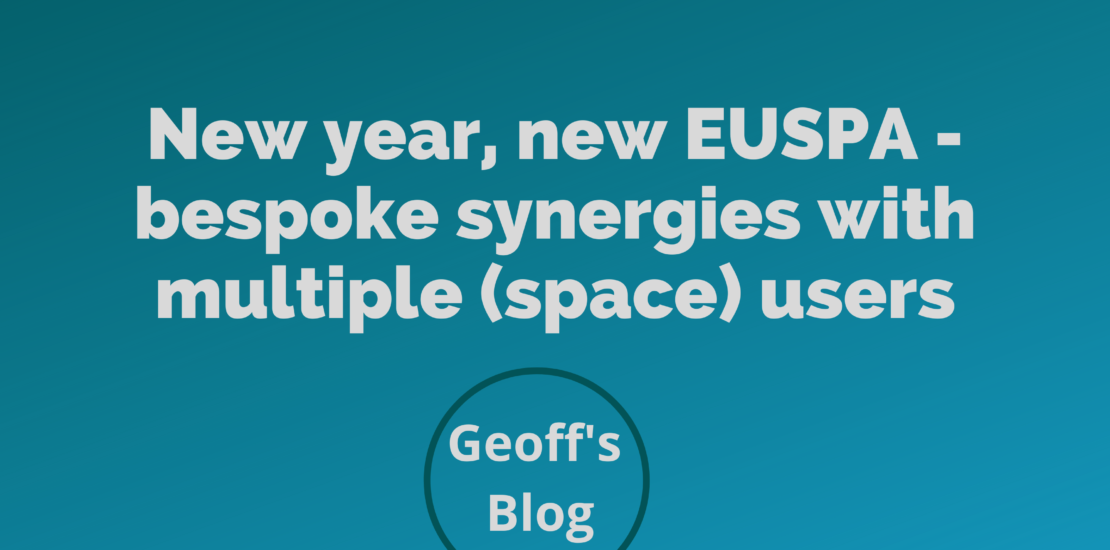- January 27, 2021
- Posted by: EARSC
- Categories: Blogs, EARSC News, Geoff's Blog

By Sandra Cabrera Alvarado, Aaron Scorsa, Geoff Sawyer
The first EOcafe of the year 2021 provoked a great deal of interest with over 200 joining us in the virtual cafe to hear about the new European Union Agency for the Space Programme (EUSPA). It is fair to affirm that the (European) space community is eagerly awaiting the entrance of this new player and its influence in the future of the EU space programme activities, especially for Copernicus. Once the new European Space Legislation is adopted, the current European GNSS Agency (GSA) will be transformed into the EUSPA with its responsibilities extended beyond the current role of market development of EGNOS and Galileo:
- Fostering commercial use of Copernicus,
- Federating the user requirements for Govsatcom[1] and SST[2].
- Maximising synergies in the field of space innovation.
Fiammetta Diani, who is the Head of Market Development Department of the European GNSS Agency outlined what will be the role and mission of the new EUSPA according to the EU regulation proposal. In the EU space programme’s governance scheme, EUSPA’s role will be an umbrella European agency complementing other actors’ tasks with respect to downstream applications, focusing on creating synergies between EGNOS, Galileo, Copernicus, GOVSTACOM, and SSA programmes through transversal activities.
The ex-GSA will no longer be an agency dedicated to the EU GNSS (Galileo and EGNOS) programmes, but an agency aiming to foster synergies amongst the EU space programmes promoting the downstream/applications market development and user uptake sectors.
For the EO services community, EUSPA will focus on the enhancement of Copernicus data exploitation aiming to increase new users, new businesses and raise the competitiveness of the companies. In other words, EUSPA will be a user oriented operational agency. To do so, Fiammetta explained, their strategy is to focus more on the ‘other users’ who are researchers and non-governmental users but with a main focus on the private users while creating synergies across European space assets. Consequently, the challenge ahead is to identify the similarities and differences of the EU GNSS and Copernicus users.
Fiammetta acknowledged that although the EO and Galileo value chains are different, to achieve this goal relies on the building of a good knowledge of the user and the market. For this purpose, GSA has based this knowledge in the Galileo experience through the issuing of (six) biennial market reports[3] focused on the technology and market segments research, identifying the user communities and needs in the field of navigation. Along with this, the Horizon2020 programme has served as a key tool to develop specific products for later commercializing them.
While undertaking this market monitoring GSA has identified convergent sectors where Copernicus and Galileo have common users and sectors where these lacks of presence. For example, the transport sector is a prominent market of Galileo where Copernicus is less present, on the other hand, in the environmental sector, Copernicus is leading and Galileo lacks presence. Yet, she points out the agricultural, maritime and forestry sectors synergies are more natural to be developed.
According to Justyna Redelkiewicz, Head of Sector LBS, Market & Technology with GSA, as part of the preparatory work of EUSPA, the Agency has already prepared a ‘consolidation market monitoring report’ considering how to address the relevant markets for GNSS and Copernicus in a coherent manner. This report is planned to be released in the first quarter of 2021. Justyna mentioned several Copernicus’ market reports were used in its formulation such as EARSC reports[4], and raised a call to the industry users for input. Furthermore, Justyna mentioned that this kind of effort is important to assist the EO industry by generating accessible information on market projections.
Although Galileo and Copernicus provide different services, similarities in its users have been identified according to Eduard Escalona Zorita, Market Development Innovation Officer with European GNSS Agency. Raising awareness, however, is desired for both the Galileo and Copernicus communities sending the message that both programmes can offer a complementary solution to users. Three categories of market have been identified:
- Those sectors which are relevant for GNSS alone e.g aviation
- Those sectors which are relevant for Copernicus alone e.g climate change
- Those sectors which are important for both technologies; agriculture and urban have been cited as examples.
In this last category, synergies between the two technologies are more likely.
Finally, regarding other mechanisms, the new EUSPA encourages the industry to approach its application specialists to assist them in their business projects and also to be attentive to the incoming Horizon Europe calls to be launched this year. EUSPA acceleration programmes are also contemplated. An Entrepreneur Day will be announced very soon to assist for example in matchmaking and developing new EO ideas.
Whilst waiting for the EUSPA to take shape in its expanded role, it is clear that identifying synergies is one of its main and most challenging objectives to fulfil in this incoming era of the EU space programme. Technology readiness and users’ skills remain paramount factors to consider in order to succeed in these synergies development. EARSC has a number of projects [5] which can complement EUSPA actions and looks forward to working with EUSPA in such an integrated view of the Copernicus-Galileo future ecosystem where the user is placed in first place by focusing also on the users of the EO private sector.
[1] https://www.gsa.europa.eu/govsatcom
[2] https://www.satcen.europa.eu/page/ssa
[3] More information about it may be found here: https://www.gsa.europa.eu/market/market-report and https://www.gsa.europa.eu/european-gnss/gnss-market/gnss-user-technology-report
[4] EARSC Taxonomy report
[5] Some EARSC projects information can be found: FIRE fire-forum.eu PARSEC Accelerator parsec-accelerator.eu e-shape e-shape.eu
